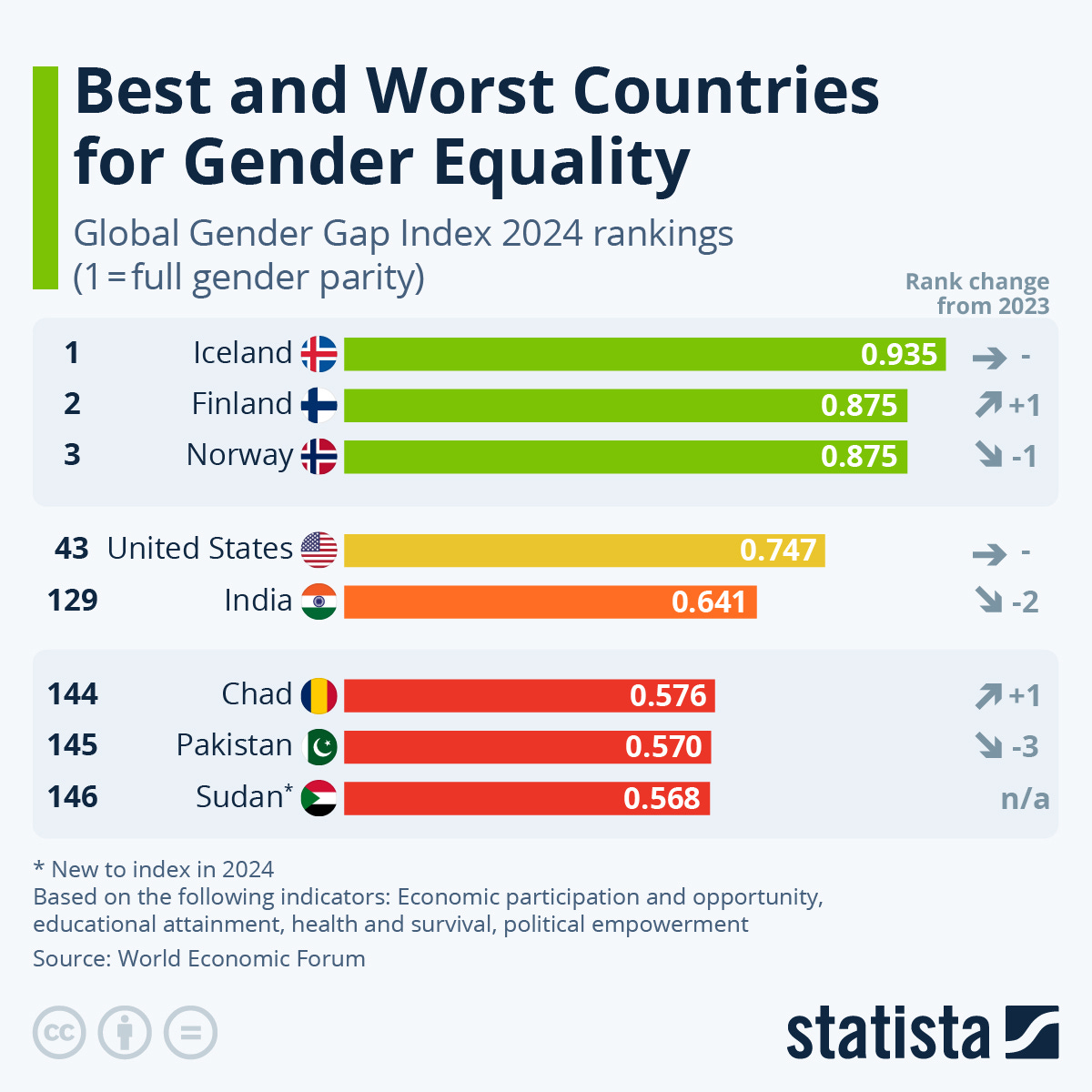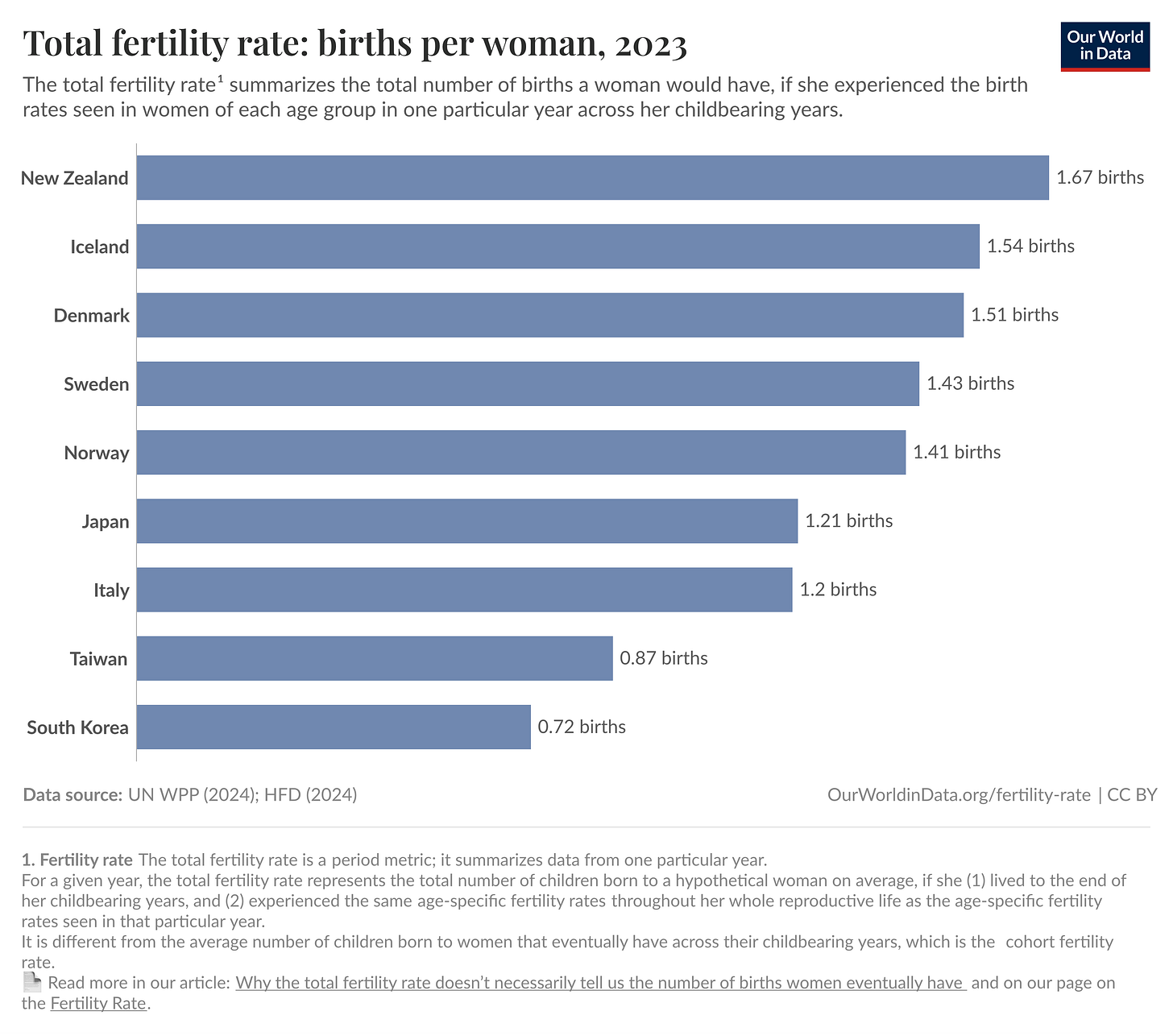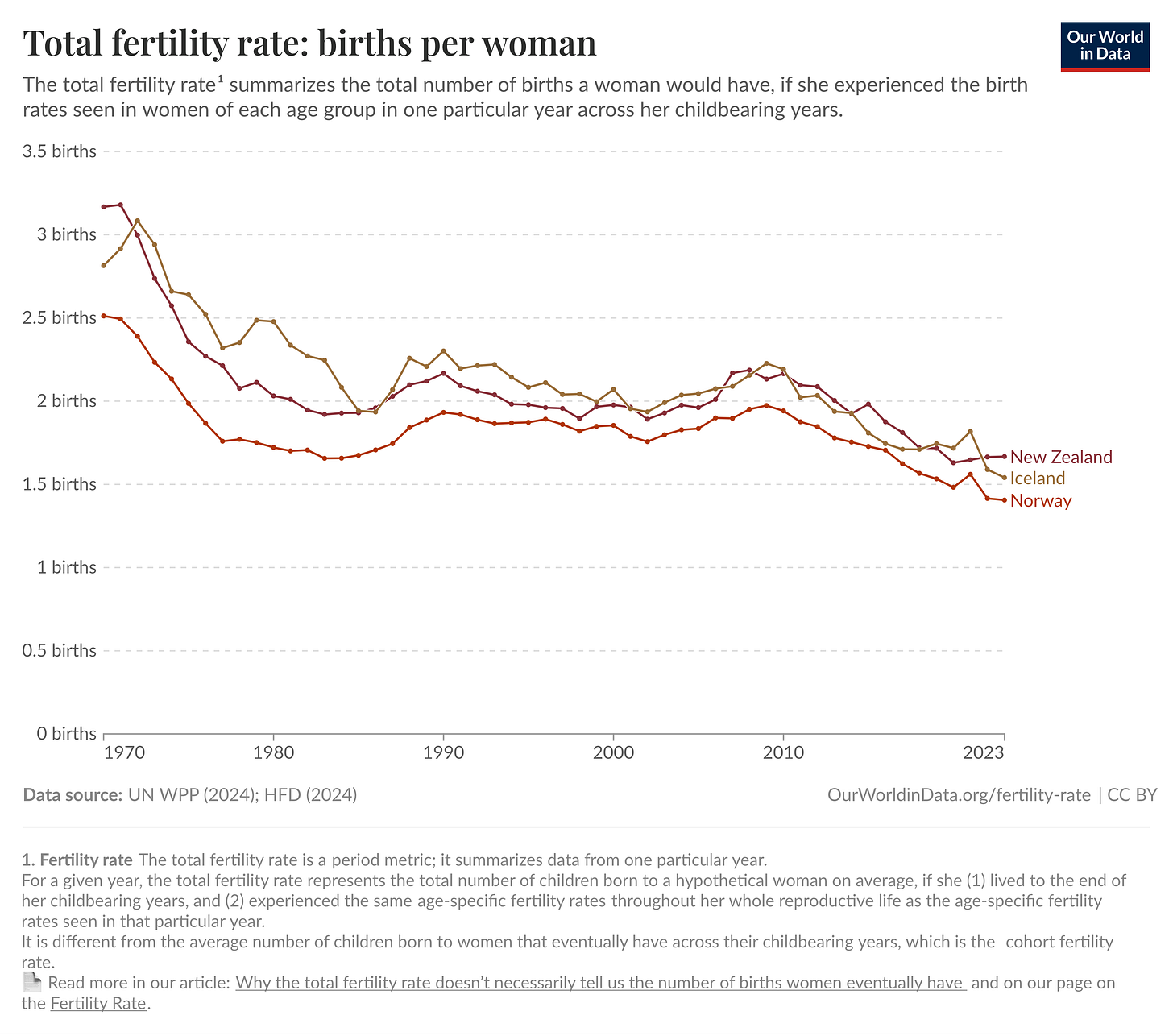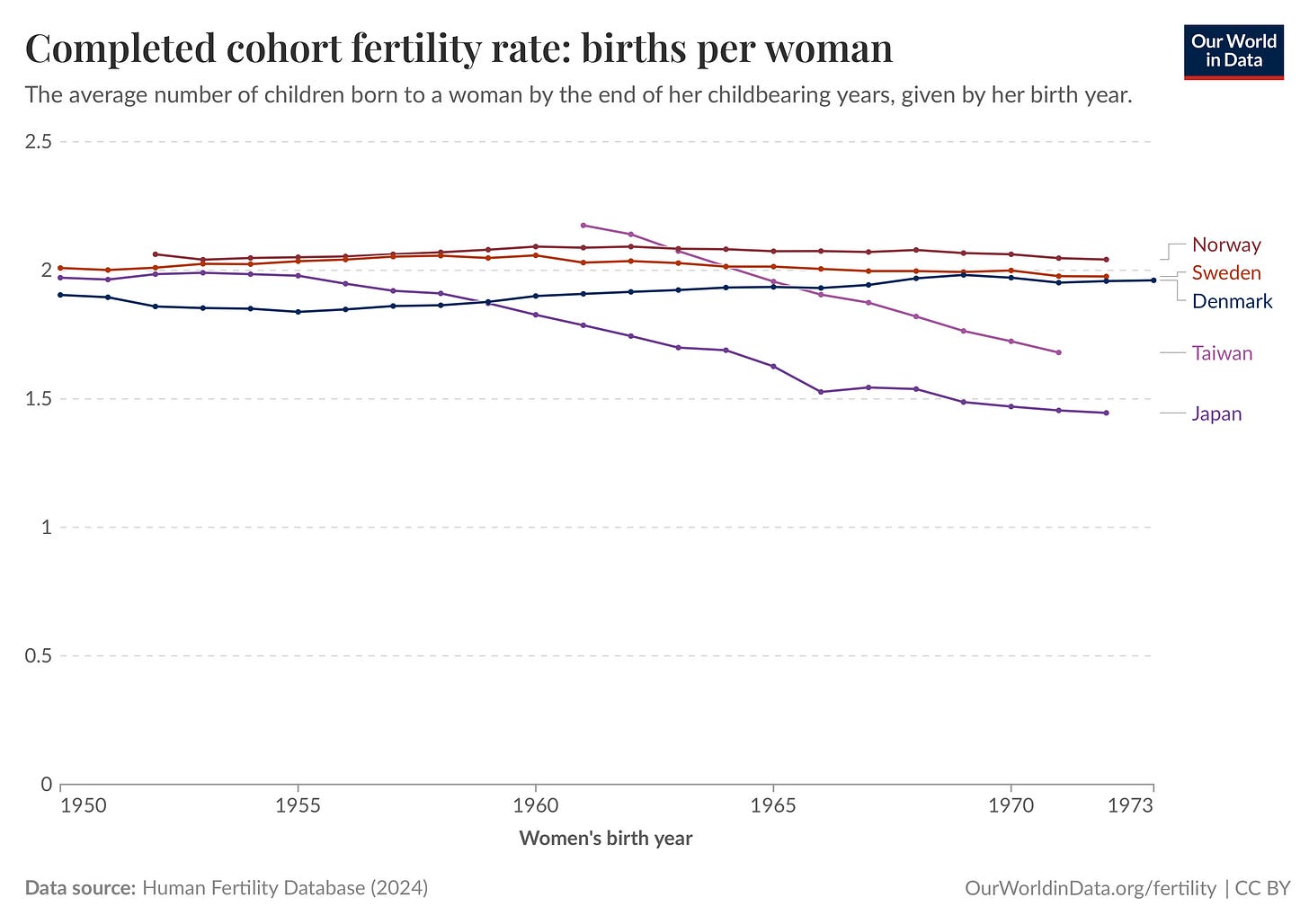A popular hypothesis is that feminism is the primary cause of the falling fertility rate. The idea is that women are choosing to have a career over having children. In other words, men are standing ready to have a large number of children, but women are rejecting them and insist that they rather be boss babes than home raising children.
We can test this hypothesis by checking various prediction we can make from this "theory":
The more feminist a country is, the lower the birth rate will be.
Men want significantly more children than women
Birth rate data should show historical fall, mirroring evolution of feminism in a country.
Anyone who has done any kind of data analysis to determine what factor is important knows we must exclude confounding factors. Ergo, to make this comparison, we ought to compare countries with many similarities.
One of the biggest factors in how societies operate is how rich the country is. Ergo, we should compare rich countries with other rich countries ideally. And preferably poor countries with other poor countries.
Do More Feminist Countries Have Lower Fertility Rate?
Fertility rate has changed over time, and I want to talk later about why it has changed. For that reason, it is useful to look at some different data. Let us start with the year 2010. The most feminist countries are topping the chart. They have birth rates either above the replacement rate or slightly above.
Notice the two top countries? Iceland is rated as the most feminist country in the world. New Zealand was the country that first gave women the right to vote. Who is at the bottom? All countries famous for gender inequality, sexism and macho culture.
But you will argue the fertility rate is much lower in all these feminist countries today. That is indeed true, and we will get to explanations for that. But notice how the ranking between the countries in 2023 has not fundamentally changed.
The countries which are more gender equal are the top and the ones with a bigger problem with sexism and which lack welfare policies aimed at families, women, and children. Notice how South Korea is at the very bottom this time. That is not surprising. This is perhaps the modern country where women face the most sever struggles.
This article paints a dire picture of the situation: South Korea’s misogyny problem
Yet Korea ranks low in global indexes of gender equality, such as the World Economic Forum Global Gender Gap Report. Incidents of violence against women, including domestic assault, workplace sexual harassment, rape, and murder, have become alarmingly frequent. In a 2015 study by the South Korean government, 80 percent of respondents — the vast majority of whom were women — reported they had been sexually harassed in their workplace. Human Rights Watch reported that nearly 80 percent of male respondents admitted to violent acts against an intimate partner in a 2017 survey.
This situation has given rise to the South Korean 4B movement, which opposes marriage and having children.
By refusing to marry, have children, engage in romance, or participate in sexual relationships with men, 4B feminists seek to redefine their lives outside the confines of traditional gender roles.
Extreme misogyny where fantasies around violence against women is spreading like wildfire in South Korea. And we wonder why their birth rates drop like a stone?
Okay, before explaining the overall fertility rate drop, I want to focus on debunking the feminism is at fault claim. So next up is the prediction that women should be the limiting factor in relationships when it comes to having more children.
Do Women or Men Want Fewer Children
In my native Norway there is a concern about the fertility rate and Norway, like many Nordic countries, has excellent statistics on these things. Most Nordic countries have been stable democracies with a strong emphasis on data-driven politics for a long time. And emphasis on statistics to inform political decisions has been a cornerstone since the founding of Norway as a modern state.
So Nordic countries are actually a superb place to look for answers, especially since feminism evolved here very early on. Paid maternity leave came in Norway already in 1908. The US still does not have that in 2025.
Anyway, the Norwegian Statistical Bureau (SSB) has done extensive studies of this which was presented by Norwegian Broadcasting (NRK).
Women and men got asked how many children they wanted, and an average was calculated. What SSB found was that women wanted 2.36 children on average, while men wanted 2.09 children.
When we look at reasons for couples not having more children, it is more likely that the state reason is that the husband does not want more children than the wife. The economic burden of a need for a bigger apartment to have more children is a more prevalent factor limiting the birth rate than women not wanting children.
Women also generally want to have children before turning 30 unlike what tradcons like to claim. The average age for having children desired by women is 26.7. For men, it is 28 years old.
34 percent of women want a third child. Only 25 percent of men want that. And that is the primary issue we find in Norwegian statistical analysis. The birth rate drop has not happened because women choose to not have children at all but because those families who used to have 3 children now have 2. And that is more due to the wishes of men than the wishes of women.
And frankly, there is nothing surprising about that. Ever since I grew up in the 1980s, I have heard about couples getting into relationship problems because the girlfriend or wife wants children, but the boyfriend of husband doesn't. That somehow the media has created an impression of the opposite is nothing short of right-wing propaganda. It simply does not match reality.
Did Birthrate Drop with Feminism?
If feminism is the main cause of birth rates dropping, we should be able to see that reflected in the data. Drops should happen when women's rights advance, and increase when they retract.
Let us look at long-term trends for three very feminist countries, Norway, New Zealand and Iceland. We see a dramatic drop from the 1970s to the 1980s. That corresponds to the use of the birth control pill. It became widely used in the 1970s and reached its peak in the 1980s.
Notice how birth rates start picking up again towards the end of the 1980s? That is actually when feminism takes hold. This is the period when Nordic countries sees women entering politics. Norway got its first female prime minister Gro Harlem Bruntland in 1981 and Iceland their first female president Vigdís Finnbogadóttir in 1980. The same prime minister was behind the push for the right of women to choose abortion themselves in 1978.
In other words, when women's participation in politics and rights start to expand the fertility rate has actually stabilized. When the presence of far more women in politics and women's issues have turned into real political choices, the birth rate starts increasing.
There is some stabilization then for a while before a slight dip towards 2002. Why? I remember that time well. It was getting increasingly difficult for parents to put children in pre-school. It became a big political issue. In 2003 all children from one-year-old got a right to pre-school in Norway at greatly subsidized rates. A massive increase in pre-school capacity happened in Norway.
And you see that reflected in the statistics. Birth rates grow from 2003 to 2009. What happens in 2009? Well, 2008 was when the financial crisis hit. That produced a lot of uncertainty and economic difficulties around the world that caused many to put off having children.
So let me summarize: The birth rates have been negatively affected by the birth control pill and the 2008 financial crisis. It has been positively affected by advances in women's rights and welfare services for families with children.
Contrary to what the conservative hypothesis would imply, significant advances in feminism has not correlated with drops in birth rate. In fact the opposite has happened.
Why is the Fertility Rate too Low?
When I bring up these issues people will argue that well you are not above replacement rate so it doesn't matter. Well, it does matter for several reasons:
If the most macho and sexist countries have among developed democracies have the lowest birth rate then that is clearly not the path to follow.
1.67 birth rate in New Zealand and 0.73 in South Korea is a massive difference. The latter is catastrophic. Most countries can handle minor population decline.
Norway and other Nordic countries have managed fine to have fertility rates of 1.9 while being very feminist. Some have even been above replacement rate. At 1.9, society can mostly manage. We can handle slow population declines. 0.73 is too dramatic. In other words, you cannot simply dismiss a 1.9 rate as failure.
Also, we must question whether the fertility rate has really dropped as much as you think. This article clarifies this issue: Why the total fertility rate doesn’t necessarily tell us the number of births women eventually have
The cohort fertility rate, which measures how many children women born in a particular year eventually have, is a better measure.
It indicates that the average number of children women eventually have has been stable around 2 in Sweden for a long time. The same has not been the case in rich Asian countries. You can see Scandinavian countries have kept a very stable cohort fertility rate.
In other words, feminist Scandinavia is in much better shape than it seems like conservative Asian democracies are the ones really having a genuine sharp drop in number of children that women have.
In other words, the reality for Nordic countries is not as dire as it seems. It is primarily an artifact of women having children later.
It is not the full explanation, but we can get into more details. I wrote an article about the cost of having children.
Read more: Couples Cannot Afford to Have Kids
The cost issue is often dismissed by people on the ground that we are richer today than in the past. But then you don't know the issue in detail. You are not considering what is called the Baumol effect. Don't know what the Baumol effect is and its effect on family formation? Well, then read my article.
The other factor is that society is fundamentally changed economically and technologically. It is absurd to be nostalgic about a 1950s world when that operated on entirely different technology and professional careers. Todays' world requires a much longer education. That is a key reason why families have children later.
Families in their early 20s today are either in education or deep in student debt. Or they have little saved up cash as they have not yet had a career. You cannot use old solutions to new problems. The way forward is new policies to deal with the new realities we face, not dialing the clock back to 1950.
Why Do Poorer, Less Developed Countries Have Higher Birthrates?
The issue in countries like Italy, Japan, and South Korea is that women get caught in the middle. You go from a Taliban style society where women are not allowed to do anything to being reluctantly allowed to have an education and a job. They even get a say in whom they marry and when.
The issue is that women then end up with a double burden. They have to take care of their husband at home, housework, and children while working a full-time job. This makes women exhausted and makes marriage and traditional family life undesirable.
But there is an elementary and obvious solution: Have men contribute more. When society has lots of extra economic activity generated by women, it makes sense that men scale back their paid work effort and contribute more with the unpaid work at home.
And this hypothesis actually has supporting data. Professor of Psychology at the University of Southern California, Darby Saxbe examined this idea: Do men hold the key to increasing births?
Below is one of her data plots showing that fertility rate is correlated with male participation in unpaid work is positively correlated with higher fertility rate.

And there is nothing surprising about this. It is akin to saying water is wet. You can hear plenty of complaints and testimonies from women about exactly this point. In this case, the anecdotes and the data line up very well.
I think the issue many conservatives struggle with is that they feel it should be possible to live like the old days now that we are richer. But no, you won't because many of the things we need to buy have dramatically increased in price in relative terms. That is the point I make here: Couples Cannot Afford to Have Kids.
Land is much cheaper in Africa than Iceland. Housing is much cheaper in Africa than in Germany. It is all supply and demand. In a poorer country, the lower demand and economic power of people leads to much cheaper land. It also leads to much lower salaries for builders, which make houses much cheaper.
Ergo, there is just no way of emulating a poorer country in a modern setting. The relative prices of things have thoroughly changed. So has expectations for children. You cannot raise your children on the food, toys, and clothes children in Africa get because they live in a society where everyone around them would mock them for it.
Economist Adam Smith made this point long time ago in his most famous work, The Wealth of Nations. He remarked on how it was perfectly acceptable for people in France to not walk around with shoes. Going barefoot was normal there. In Britain, in contrast, it would bring the outmost shame. Thus, every society has a minimum standard of living to live up to in order to avoid shame and stigma. Also, your children need a much higher level of schooling and education to succeed in modern society.
In the Norway my grandparents grew up in, you can take something like 8 years of schooling and just walk into a factory to get a job on the spot. That world no longer exists. It is why parents in China continue to only get one child. All the necessary investment they require in their child to get ahead in the highly competitive Chinese economy only allow them to have one child.
This particular concept has been examined by researchers: The expected and required investment in children in a society. If the needed investment in children rise faster than parent income and resources, you will see fertility rates drop or families putting off having children.
On the other hand, older couples are far more affluent today than in the past. Rising house values represent a de-facto massive wealth transfer from the young to the old. In other words, we require policies that somehow shift more economic resources towards young couples wanting to have children. And we are not talking small amounts here. We talk substantial amounts.
I look at my native Norway, the cost of housing is now relative to normal salaries, something like 5-6 times higher than in the time of my parents. It leaves the older generation with massive assets and wealth, but the young is utterly lacking the capital and means to secure a home suitable to raise children with the support expected and needed in today's society.
What Needs to Be Done?
When a society faces a war situation, all the society is transformed to meet that challenge. An eradication of the whole population, not from death in war, but from plummeting birth rates ought to muster a similar level of alarm and need for bold action.
It could mean e.g., cheap subsidized rental for families with young children. It could mean e.g. that student couples can get an apartment suitable for having children so that it is actually possible to have your first child while a student. It could mean a guaranteed minimum income. Some kind of UBI. Because a big part of why young couples hold off having children today is economic uncertainty.
Temporary hiring is much more common for young people today. Combine that with much time spent in educational facilities and little saved up money and it is clear that nobody wants to risk putting a child to this world while not knowing if they have the economy to properly take care of that child.
How could people manage before? Again, the world is entirely different today. We move around a lot more. We don't live in close-knit societies of old friends and family. The high-level specialization of modern society means you often have to move to find a job. Your family cannot easily step up and provide housing and help because you may live in an entirely different place.
In such a situation, there is no way around a much more active state involvement in our lives. The falling birth rate is not merely a issue at the individual level but a societal problem.
Conservatives here hit an ideological contradiction. Margaret Thatcher suggested there is no such thing as society, only individuals. The idea is that only individual choices matter and we don't owe anybody else anything.
But if that is the case, you should not care about people not having children. That is their choice. The impact on society doesn't matter because society doesn't matter. Only individuals matter. Oh, you don't agree? Well, if society matters, then the state has a role to play in our lives.
If higher birth rate is desirable for society, then society has to be able to facilitate that. Birth rate is a concern to society, not to the individuals. Individuals manage just fine with zero birth rate. Society does not.
We must dispel with the myth that only individuals matter and the common good is irrelevant.
Resources
Some useful links to this topic:
Fruktbarheitsfallet - A detailed analysis of why birthrates dropped in Norway by Norwegian broadcasting (NRK) using SSB statistics.
Do men hold the key to increasing births? - Professor Darby Saxbe writing about the importance of male contributions in the home.
The global decline of the fertility rate - Our World in Data gives a detailed analysis with statistics.
Child wishes – a survey on fertility, working life and family policy - A Norwegian study of the reason why fertility rates have dropped.











I absolutely hear and agree with this. But there are some assumptions around human rights and equality baked into this I think.
On the other hand, there is a very well documented phenomenon I’m familiar with as I was an volunteer fundraiser for UNICEF for many years. The more you educate girls in a given population, the less children they have. So educating girls in Africa especially became a focus, as this is believed to be downstream from hunger and poverty. Fewer children, fewer mouths to feed. More educated girls tend to have more options, delay pregnancy and have fewer children, in which they invest more in each. Uneducated girls in the Africa often are unaware of birth control options or even how babies are conceived.
There is intense backlash from conservative religious forces in Africa to this assistance and mindset — the terrorist organization Boko Harem is entirely based in opposing this, on keeping women and girls uneducated and subordinate while refusing the influence of western education and aid. They tend to kidnap girls from schools and enslave them.
So when they say feminism is lowering the birth rates, they mean they’d rather girls have no other options but to make babies and take care of the home. They are ideologically aligned with Boko Harem, apparently
I think problem defending Feminism, is that Patriarchy (or anti-Feminism) didn't idolize all man in past, but subset of it.
Wannabe Patriarch see themselves as idolized landowner, with wives, multiple children, and farmhands.